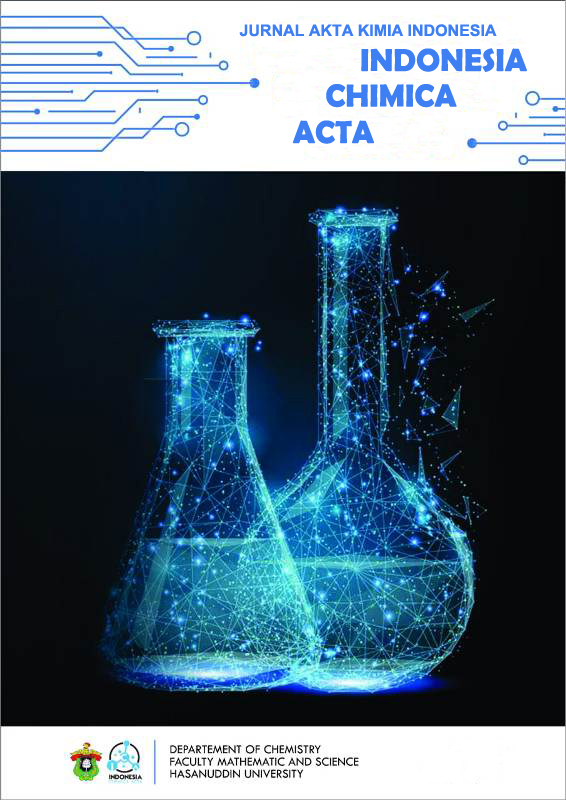Main Article Content
Abstract
Keywords
Article Details
References
- Ahmed, S., Ikram, S. 2015. Silver Nanoparticles: One Pot Green Synthesis Using Terminalia arjuna Extract for Biological Application. J. Nanomed Nanotechnol 6(4): 1-6, ISSN: 2157-7439 JNMNT
- Buzea, C., Pacheco, I. I. dan Robbie, K., 2007, Nanomaterials and nanoparticles: sources and toxicity, Biointerphases, 2(4):17-71.
- Chandran, S.,P., Chaundary M., Pasricha R., Ahmad A., Sastry M.,. 2006. Synthesis of gold nanotriangles and silver nanoparticles using Aloe Vera plant extract. Biotechnology progress 22 : 577-583
- Dangi, R., Shakya, S. 2013. Preparation, Optimization and Characterization of PLGA Nanoparticle. Int J of Pharm & Life Sci. 4(7): 2810-2818.
- El-Nour, K. M. M. A., Eftaiha, A., Al-Warthan, A. dan Ammar, R. A. A., 2010, Synthesis and Application of Silver Nanoparticles, Arabian Journal of Chemistry, 3: 135–140.
- Engida, M.A., Kasim, S.N., Tsigie, A.Y., Ismadji, S., Huynh, H.L., and Ju, H.Y. 2012. Extraction, identification and quantitative HPLC analysis of flavonoids from sarang semut (Myrmecodia pendan). Industrial Crops and Products 41 (2013) 392– 396. Elsevier
- Gupta V, Karar PK. Optimization of Process Variables for the Preparation of Chitosan-Alginate Nanoparticle. Int J Pharm Pharm Sci. 2011; 3(2): 78-80.
- International Diabetes Federation (IDF). (2015). IDF Diabetes Atlas Seventh Edition. International Diabetes Federation (IDF). Diperoleh tanggal 30 Januari 2018 dari https://www.oedg.at/pdf/1606_IDF_Atlas_2015_UK.pdf
- Khan, Z., Singh, T., Ijaz, J., Yousif, A., Al-thabaiti, S. A. dan El-mossalamy, E. H., 2013, Colloids and Surfaces B : Biointerfaces Starch-directed green synthesis , characterization and morphology of silver nanoparticles, Colloids and Surfaces B: Biointerfaces, 102: 578–584
- Mittal AK, Tripathy D, Choudhary A, Aili PK, Chatterjee A, Singh IP, Banerjee UC (2015) Bio-synthesis of silver nanoparticles using Potentilla fulgens Wall. ex Hook. and its therapeutic evaluation as anticancer and antimicrobial agent. Mater Sci Eng C Mater Biol Appl 53:120–127
- Mukunthan, K.S., Balaji, S. 2012. Cashew apple juice (Anacardium occidentale L.) speeds up the synthesis of silver nanoparticles. Intl. J. Green Nanotechnology. 4(2): 71–79.
- Philip, D. 2010. Green Synthesis of Gold and Silver Nanoparticles Using Hibiscus rosa sinensis. Phys. E. Vol., 42: 1417–1424.
- Rai, M., Yadav, A., and Gade, A. 2008. CRC 675— current trends in phytosynthesis of metal nanoparticles.Critical Reviews in Biotechnology. 28(4): 277–284.
- Saeb, A. T. M., Alshammari, A. S., Al-brahim, H. dan Al-rubeaan, K. A., 2014, Production of Silver Nanoparticles with Strong and Stable Antimicrobial Activity against Highly Pathogenic and Multidrug Resistant Bacteria, The Scientific Journal, 1-9.
- Shankar, S. S., Rai, A., Ahmad, A. dan Sastry, M., 2004, Rapid Synthesis of Au, Ag, and Bimetallic Au Core-Ag Shell Nanoparticles Using Neem Azadirachta indica Leaf Broth, Journal of Colloid and Interface Science, 275(4): 496–502.
- Singh, C., Baboota, R.K., Naik, P.K., and Singh, H. 2012. Biocompatible Synthesis of Silver and Gold Nanoparticles Using Leaf Extract of Dalbergia Sissoo. Research Article 3(4): 279-285.
- Torresdey, J.L., Gomez, E., Peralta-Videa, J.R., Parsons, J.G., Troiani, H., Jose-Yacaman, M. 2003. Alfalfa sprouts : A natural source for the synthesis of silver nanoparticles. Langmuir: 1357-1361
References
Ahmed, S., Ikram, S. 2015. Silver Nanoparticles: One Pot Green Synthesis Using Terminalia arjuna Extract for Biological Application. J. Nanomed Nanotechnol 6(4): 1-6, ISSN: 2157-7439 JNMNT
Buzea, C., Pacheco, I. I. dan Robbie, K., 2007, Nanomaterials and nanoparticles: sources and toxicity, Biointerphases, 2(4):17-71.
Chandran, S.,P., Chaundary M., Pasricha R., Ahmad A., Sastry M.,. 2006. Synthesis of gold nanotriangles and silver nanoparticles using Aloe Vera plant extract. Biotechnology progress 22 : 577-583
Dangi, R., Shakya, S. 2013. Preparation, Optimization and Characterization of PLGA Nanoparticle. Int J of Pharm & Life Sci. 4(7): 2810-2818.
El-Nour, K. M. M. A., Eftaiha, A., Al-Warthan, A. dan Ammar, R. A. A., 2010, Synthesis and Application of Silver Nanoparticles, Arabian Journal of Chemistry, 3: 135–140.
Engida, M.A., Kasim, S.N., Tsigie, A.Y., Ismadji, S., Huynh, H.L., and Ju, H.Y. 2012. Extraction, identification and quantitative HPLC analysis of flavonoids from sarang semut (Myrmecodia pendan). Industrial Crops and Products 41 (2013) 392– 396. Elsevier
Gupta V, Karar PK. Optimization of Process Variables for the Preparation of Chitosan-Alginate Nanoparticle. Int J Pharm Pharm Sci. 2011; 3(2): 78-80.
International Diabetes Federation (IDF). (2015). IDF Diabetes Atlas Seventh Edition. International Diabetes Federation (IDF). Diperoleh tanggal 30 Januari 2018 dari https://www.oedg.at/pdf/1606_IDF_Atlas_2015_UK.pdf
Khan, Z., Singh, T., Ijaz, J., Yousif, A., Al-thabaiti, S. A. dan El-mossalamy, E. H., 2013, Colloids and Surfaces B : Biointerfaces Starch-directed green synthesis , characterization and morphology of silver nanoparticles, Colloids and Surfaces B: Biointerfaces, 102: 578–584
Mittal AK, Tripathy D, Choudhary A, Aili PK, Chatterjee A, Singh IP, Banerjee UC (2015) Bio-synthesis of silver nanoparticles using Potentilla fulgens Wall. ex Hook. and its therapeutic evaluation as anticancer and antimicrobial agent. Mater Sci Eng C Mater Biol Appl 53:120–127
Mukunthan, K.S., Balaji, S. 2012. Cashew apple juice (Anacardium occidentale L.) speeds up the synthesis of silver nanoparticles. Intl. J. Green Nanotechnology. 4(2): 71–79.
Philip, D. 2010. Green Synthesis of Gold and Silver Nanoparticles Using Hibiscus rosa sinensis. Phys. E. Vol., 42: 1417–1424.
Rai, M., Yadav, A., and Gade, A. 2008. CRC 675— current trends in phytosynthesis of metal nanoparticles.Critical Reviews in Biotechnology. 28(4): 277–284.
Saeb, A. T. M., Alshammari, A. S., Al-brahim, H. dan Al-rubeaan, K. A., 2014, Production of Silver Nanoparticles with Strong and Stable Antimicrobial Activity against Highly Pathogenic and Multidrug Resistant Bacteria, The Scientific Journal, 1-9.
Shankar, S. S., Rai, A., Ahmad, A. dan Sastry, M., 2004, Rapid Synthesis of Au, Ag, and Bimetallic Au Core-Ag Shell Nanoparticles Using Neem Azadirachta indica Leaf Broth, Journal of Colloid and Interface Science, 275(4): 496–502.
Singh, C., Baboota, R.K., Naik, P.K., and Singh, H. 2012. Biocompatible Synthesis of Silver and Gold Nanoparticles Using Leaf Extract of Dalbergia Sissoo. Research Article 3(4): 279-285.
Torresdey, J.L., Gomez, E., Peralta-Videa, J.R., Parsons, J.G., Troiani, H., Jose-Yacaman, M. 2003. Alfalfa sprouts : A natural source for the synthesis of silver nanoparticles. Langmuir: 1357-1361
